First-line combination therapy versus first-line monotherapy for primary hypertension
- PMID: 32026465
- PMCID: PMC7002970
- DOI: 10.1002/14651858.CD010316.pub3
First-line combination therapy versus first-line monotherapy for primary hypertension
Abstract
Background: This is the first update of a review originally published in 2017. Starting with one drug and starting with a combination of two drugs are strategies suggested in clinical guidelines as initial treatment of hypertension. The recommendations are not based on evidence about clinically relevant outcomes. Some antihypertensive combinations have been shown to be harmful. The actual harm-to-benefit balance of each strategy is unknown.
Objectives: To determine if there are differences in clinical outcomes between monotherapy and combination therapy as initial treatment for primary hypertension.
Search methods: The Cochrane Hypertension Information Specialist searched the following databases for randomised controlled trials up to April 2019: the Cochrane Hypertension Specialised Register, the Cochrane Central Register of Controlled Trials (CENTRAL), MEDLINE (from 2005), Embase (from 1974), the World Health Organization International Clinical Trials Registry Platform, and ClinicalTrials.gov. We used no language restrictions. We also searched clinical studies repositories of pharmaceutical companies, reviews of combination drugs on the US Food and Drug Administration and European Medicines Agency websites, and lists of references in reviews and clinical practice guidelines.
Selection criteria: We included randomised, double-blind trials with at least 12 months' follow-up in adults with primary hypertension (systolic blood pressure/diastolic blood pressure 140/90 mmHg or higher, or 130/80 mmHg or higher if participants had diabetes), which compared combination of two first-line antihypertensive drugs with monotherapy as initial treatment. Trials had to include at least 50 participants per group and report mortality, cardiovascular mortality, cardiovascular events, or serious adverse events.
Data collection and analysis: Two review authors independently selected trials for inclusion, evaluated the risk of bias, and performed data entry. The primary outcomes were mortality, serious adverse events, cardiovascular events, and cardiovascular mortality. Secondary outcomes were withdrawals due to drug-related adverse effects, reaching blood pressure control (as defined in each trial), and blood pressure change from baseline. Analyses were based on the intention-to-treat principle. We summarised data on dichotomous outcomes as risk ratios (RR) with 95% confidence intervals (CI).
Main results: This update included one new study in which a subgroup of participants met our inclusion criteria. As none of the four included studies focused solely on people initiating antihypertensive treatment, we asked investigators for data for this subgroup. One study (PREVER-treatment 2016) used a combination of thiazide-type diuretic/potassium-sparing diuretic; as the former is not indicated in monotherapy, we analysed this study separately. The three original trials in the main comparison (monotherapy: 335 participants; combination therapy: 233 participants) included outpatients, mostly European and white people. Two trials only included people with type 2 diabetes; the remaining trial excluded people treated with diabetes, hypocholesterolaemia, or cardiovascular drugs. The follow-up was 12 months in two trials and 36 months in one trial. It is very uncertain whether combination therapy versus monotherapy reduces total mortality (RR 1.35, 95% CI 0.08 to 21.72), cardiovascular mortality (zero events reported), cardiovascular events (RR 0.98, 95% CI 0.22 to 4.41), serious adverse events (RR 0.77, 95% CI 0.31 to 1.92), or withdrawals due to adverse effects (RR 0.85, 95% CI 0.53 to 1.35); all outcomes had 568 participants, and the evidence was rated as of very low certainty due to serious imprecision and for using a subgroup that was not defined in advance. The confidence intervals were extremely wide for all important outcomes and included both appreciable harm and benefit. The PREVER-treatment 2016 trial, which used a combination therapy with potassium-sparing diuretic (monotherapy: 84 participants; combination therapy: 116 participants), included outpatients. This trial was conducted in Brazil and had a follow-up of 18 months. The number of events was very low and confidence intervals very wide, with zero events reported for cardiovascular mortality and withdrawals due to adverse events. It is very uncertain if there are differences in clinical outcomes between monotherapy and combination therapy in this trial.
Authors' conclusions: The numbers of included participants, and hence the number of events, were too small to draw any conclusion about the relative efficacy of monotherapy versus combination therapy as initial treatment for primary hypertension. There is a need for large clinical trials that address the review question and report clinically relevant endpoints.
Copyright © 2020 The Cochrane Collaboration. Published by John Wiley & Sons, Ltd.
Conflict of interest statement
Javier Garjón: None known.
Luis Carlos Saiz: None known.
Ana Azparren: None known.
Idoia Gaminde: None known.
M José Ariz: None known.
Juan Erviti: None known.
Figures
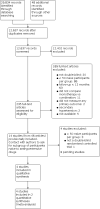
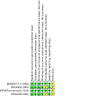
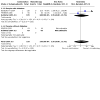

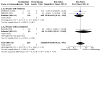
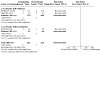
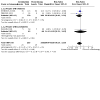
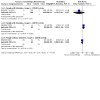
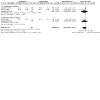

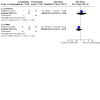
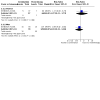
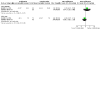
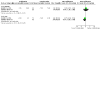



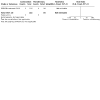

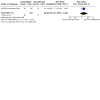
Update of
-
First-line combination therapy versus first-line monotherapy for primary hypertension.Cochrane Database Syst Rev. 2017 Jan 13;1(1):CD010316. doi: 10.1002/14651858.CD010316.pub2. Cochrane Database Syst Rev. 2017. Update in: Cochrane Database Syst Rev. 2020 Feb 6;2:CD010316. doi: 10.1002/14651858.CD010316.pub3. PMID: 28084624 Free PMC article. Updated.
References
References to studies included in this review
BENEDICT‐A 2004 {published and unpublished data}
-
- BENEDICT Group. The BErgamo NEphrologic DIabetes Complications Trial (BENEDICT): design and baseline characteristics. Controlled Clinical Trials 2003;24(4):442-61. [PMID: ] - PubMed
-
- Ruggenenti P, Fassi A, Ilieva A, Iliev IP, Chiurchiu C, Rubis N, et al. Effects of verapamil added-on trandolapril therapy in hypertensive type 2 diabetes patients with microalbuminuria: the BENEDICT-B randomized trial. Journal of Hypertension 2011;29:207-16. [PMID: ] - PubMed
-
- Ruggenenti P, Fassi A, Ilieva AP, Bruno S, Iliev IP, Brusegan V, et al. Preventing microalbuminuria in type 2 diabetes. New England Journal of Medicine 2004;351(19):1941-51. [PMID: ] - PubMed
PREMIER 2003 {published and unpublished data}
-
- Mogensen CE, Viberti G, Halimi S, Ritz E, Ruilope L, Jermendy G, et al. Effect of low-dose perindopril/indapamide on albuminuria in diabetes: preterax in albuminuria regression: PREMIER. Hypertension 2003;41(5):1063-71. [PMID: ] - PubMed
PREVER‐treatment 2016 {published and unpublished data}
-
- Fuchs FD, Fuchs SC, Moreira LB, Gus M, Nobrega AC, Poli-de-Figueiredo CE, et al. A comparison between diuretics and angiotensin-receptor blocker agents in patients with stage I hypertension (PREVER-treatment trial): study protocol for a randomized double-blind controlled trial. Trials 2011;12:53. [PMID: ] - PMC - PubMed
-
- Fuchs FD, Scala LC, Vilela-Martin JF, Mello RB, Mosele F, Whelton PK, et al. Effectiveness of chlorthalidone/amiloride versus losartan in patients with stage I hypertension: results from the PREVER-treatment randomized trial. Journal of Hypertension 2016;34(4):798-806. [PMID: ] - PubMed
-
- Fuchs FD, Scala LC, Vilela-Martin JF, Whelton PK, Poli-de-Figueiredo CE, Pereira ES, et al. Effectiveness of chlorthalidone/amiloride versus losartan in patients with stage I hypertension and diabetes mellitus: results from the PREVER-treatment randomized controlled trial. Acta Diabetologica 2021;58(2):215-20. [DOI: 10.1007/s00592-020-01611-8] - DOI - PubMed
REASON 2001 {published and unpublished data}
-
- Asmar RG, London GM, O'Rourke ME, Mallion JM, Romero R, Rahn KH, et al. Amelioration of arterial properties with a perindopril-indapamide very-low-dose combination. Journal of Hypertension. Supplement 2001;19(4):S15-20. [PMID: ] - PubMed
-
- Asmar RG, London GM, O'Rourke ME, Safar ME. Improvement in blood pressure, arterial stiffness and wave reflections with a very-low-dose perindopril/indapamide combination in hypertensive patient: a comparison with atenolol. Hypertension 2001;38(4):922-6. [PMID: ] - PubMed
-
- London GM, Asmar RG, O'Rourke MF, Safar ME. Mechanism(s) of selective systolic blood pressure reduction after a low-dose combination of perindopril/indapamide in hypertensive subjects: comparison with atenolol. Journal of the American College of Cardiology 2004;43(1):92-9. [PMID: ] - PubMed
-
- Mallion JM, Chamontin B, Asmar R, De Leeuw PW, O'Brien E, Duprez D, et al. Twenty-four-hour ambulatory blood pressure monitoring efficacy of perindopril/indapamide first-line combination in hypertensive patients: the REASON study. American Journal of Hypertension 2004;17(3):245-51. [PMID: ] - PubMed
References to studies excluded from this review
ACCELERATE 2011 {published data only}
-
- Brown MJ, McInnes GT, Papst CC, Zhang J, MacDonald TM. Aliskiren and the calcium channel blocker amlodipine combination as an initial treatment strategy for hypertension control (ACCELERATE): a randomised, parallel-group trial. Lancet 2011;377(9762):312-20. [PMID: ] - PubMed
BENEDICT‐B 2011 {published and unpublished data}
-
- Ruggenenti P, Fassi A, Ilieva A, Iliev IP, Chiurchiu C, Rubis N, et al. Effects of verapamil added-on trandolapril therapy in hypertensive type 2 diabetes patients with microalbuminuria: the BENEDICT-B randomized trial. Journal of Hypertension 2011;29(2):207-16. [PMID: ] - PubMed
DEMAND 2011 {published and unpublished data}
-
- Ruggenenti P, Lauria G, Iliev IP, Fassi A, Ilieva AP, Rota S, et al. Effects of manidipine and delapril in hypertensive patients with type 2 diabetes mellitus: the Delapril and Manidipine for Nephroprotection in Diabetes (DEMAND) randomized clinical trial. Hypertension 2011;58(5):776-83. - PubMed
MRC‐O 1992 {published data only}
ONTARGET 2008 {published data only}
-
- Yusuf S, Teo KK, Pogue J, Dyal L, Copland I, Schumacher H, et al. Telmisartan, ramipril, or both in patients at high risk for vascular events. New England Journal of Medicine 2008;358(15):1547-59. - PubMed
PATHWAY‐1 2017 {published data only}
-
- MacDonald TM, Williams B, Webb DJ, Morant S, Caulfield M, Cruickshank JK, et al. Combination therapy is superior to sequential monotherapy for the initial treatment of hypertension: a double-blind randomized controlled trial. Journal of the American Heart Association 2017;6(11):e006986. [PMID: ] - PMC - PubMed
PICXEL 2005 {published and unpublished data}
-
- Dahlof B, Gosse P, Gueret P, Dubourg O, Simone G, Schmieder R, et al. Perindopril/indapamide combination more effective than enalapril in reducing blood pressure and left ventricular mass: the PICXEL study. Journal of Hypertension 2005;23(11):2063-70. [PMID: ] - PubMed
PREVER‐prevention 2016 {published data only}
-
- Fuchs SC, Poli-de-Figueiredo CE, Figueiredo Neto JA, Scala LC, Whelton PK, Mosele F, et al. Effectiveness of chlorthalidone/amiloride versus losartan in patients with stage I hypertension: results from the PREVER-treatment randomized trial. Journal of the American Heart Association 2016;5:e004248. [DOI: 10.1161/JAHA.116.004248] - DOI
Zhang 2010 {published data only}
-
- Zhang JL, Qin YW, Zheng X, Qiu JL, Zhao XX, Zou DJ. Combination therapy with angiotensin-converting enzyme inhibitors and indapamide impairs glucose tolerance in Chinese hypertensive patients. Blood Pressure 2010;19(2):110-8. [PMID: ] - PubMed
References to studies awaiting assessment
Derosa 2013 {published data only}
-
- Derosa G, Cicero AF, Carbone A, Querci F, Fogari E, D'Angelo A, et al. Olmesartan/amlodipine combination versus olmesartan or amlodipine monotherapies on blood pressure and insulin resistance in a sample of hypertensive patients. Clinical and Experimental Hypertension 2013;35(5):301-7. [PMID: ] - PubMed
Derosa 2014 {published data only}
-
- Derosa G, Bonaventura A, Romano D, Bianchi L, Fogari E, D'Angelo A, et al. Enalapril/lercanidipine combination on markers of cardiovascular risk: a randomized study. Journal of the American Society of Hypertension 2014;8(6):422-8. [PMID: ] - PubMed
Derosa 2016 {published data only}
INSIGHT 2000 {published data only}
-
- Brown MJ, Palmer CR, Castaigne A, Leeuw PW, Mancia G, Rosenthal T, et al. Morbidity and mortality in patients randomised to double-blind treatment with a long-acting calcium-channel blocker or diuretic in the International Nifedipine GITS study: Intervention as a Goal in Hypertension Treatment (INSIGHT). Lancet 2000;356(9227):366-72. [PMID: ] - PubMed
Maeda 2009 {published data only}
-
- Maeda S, Nishizaki M, Yamawake N, Shimada H, Asano M, Ihara K, et al. Telmisartan prevents the development of atrial fibrillation in hypertensive patients. Heart Rhythm 2009;6(Suppl 5):S334.
VALIANT 2003 {published data only}
-
- Pfeffer MA, McMurray JJ, Velazquez EJ, Rouleau JL, Køber L, Maggioni AP, et al. Valsartan, captopril, or both in myocardial infarction complicated by heart failure, left ventricular dysfunction, or both. New England Journal of Medicine 2003;349(20):1893-906. - PubMed
Additional references
Access 2010 [Computer program]
-
- Microsoft Access. Microsoft Corporation, 2010. Available at: office.microsoft.com/access.
ACCOMPLISH 2008
ALTITUDE 2012
Bakris 2014
Chen 2018
-
- Chen YJ, Li LJ, Tang WL, Song JY, Qiu R, Li Q, et al. First-line drugs inhibiting the renin angiotensin system versus other first-line antihypertensive drug classes for hypertension. Cochrane Database of Systematic Reviews 2018, Issue 11. Art. No: CD008170. [DOI: 10.1002/14651858.CD008170.pub3] - DOI - PMC - PubMed
Covidence [Computer program]
-
- Covidence. Melbourne, Australia: Veritas Health Innovation, 2019. Available at covidence.org.
EMA/294911/2014
-
- European Medicines Agency. Combined use of medicines affecting the renin-angiotensin system (RAS) to be restricted - CHMP endorses PRAC recommendation, 2014. www.ema.europa.eu/docs/en_GB/document_library/Press_release/2014/05/WC50....
EROS [Computer program]
-
- EROS Early Review Organizing Software. Version 2.0. Buenos Aires: IECS (Institute of Clinical Effectiveness and Health Policy), 2009. Available at www.eros-systematic-review.org/.
ESH/ESC 2013
-
- Mancia G, Fagard R, Narkiewicz K, Redon J, Zanchetti A, Böhm M, et al. 2013 ESH/ESC guidelines for the management of arterial hypertension: the Task Force for the Management of Arterial Hypertension of the European Society of Hypertension (ESH) and of the European Society of Cardiology (ESC). European Heart Journal 2013;34(28):2159-219. [DOI: 10.1093/eurheartj/eht151] - DOI - PubMed
ESH/ESC 2018
Excel 2010 [Computer program]
-
- Microsoft Excel. Microsoft Corporation, 2010. Available at: office.microsoft.com/excel.
FDA 2014
-
- US Food and Drug Administration. ACE inhibitors: dual blockade of the RAS. wayback.archive-it.org/7993/20170112173259/http://www.fda.gov/Safety/Med... (accessed 5 August 2015).
Fu 2017
Gradman 2010
-
- Gradman AH, Basile JN, Carter BL, Bakris GL, Materson BJ, Black HR, et al. Combination therapy in hypertension. Journal of the American Society of Hypertension 2010;4(2):90-8. [PMID: ] - PubMed
He 2017
-
- He T, Liu X, Li Y, Liu XY, Wu QY, Liu ML, et al. High-dose calcium channel blocker (CCB) monotherapy vs combination therapy of standard-dose CCBs and angiotensin receptor blockers for hypertension: a meta-analysis. Journal of Human Hypertension 2017;31(2):79-88. [PMID: ] - PubMed
Heran 2012
-
- Heran BS, Chen JM, Wang JJ, Wright JM. Blood pressure lowering efficacy of potassium-sparing diuretics (that block the epithelial sodium channel) for primary hypertension. Cochrane Database of Systematic Reviews 2012, Issue 11. Art. No: CD008167. [DOI: 10.1002/14651858.CD008167.pub3] - DOI - PMC - PubMed
Higgins 2021
-
- Higgins JP, Thomas J, Chandler J, Cumpston M, Li T, Page MJ, et al (editors). Cochrane Handbook for Systematic Reviews of Interventions version 6.2 (updated February 2021). The Cochrane Collaboration, 2021. Available from.
Hilleman 1999
-
- Hilleman DE, Ryschon KL, Mohiuddin SM, Wurdeman RL. Fixed-dose combination vs monotherapy in hypertension: a meta-analysis evaluation. Journal of Human Hypertension 1999;13(7):477-83. [PMID: ] - PubMed
Hopkins 2010
-
- Hopkins KA, Bakris GL. Fixed-dose combination and chronic kidney disease progression: which is the best? Current Opinion in Nephrology and Hypertension 2010;19(5):450-5. [PMID: ] - PubMed
Hypertension Canada 2020
-
- Rabi DM, McBrien KA, Sapir-Pichhadze R, Nakhla M, Ahmed SB, Dumanski SM, et al. Hypertension Canada's 2020 comprehensive guidelines for the prevention, diagnosis, risk assessment, and treatment of hypertension in adults and children. Canadian Journal of Cardiology 2020;36(5):596-624. [DOI: 10.1016/j.cjca.2020.02.086] - DOI - PubMed
ICH 1995
-
- International Conference on Harmonisation. Clinical Safety Data Management: Definitions and Standards for Expedited Reporting. ICH Harmonised Tripartite Guideline CPMP/ICH/377/95. London: European Medicines Agency, 1995.
JNC 8 2014
-
- James PA, Oparil S, Carter BL, Cushman WC, Dennison-Himmelfarb C, Handler J, et al. 2014 evidence-based guideline for the management of high blood pressure in adults: report from the panel members appointed to the Eighth Joint National Committee (JNC 8). JAMA 2014;311(5):507-20. [DOI: 10.1001/jama.2013.284427] [PMID: ] - DOI - PubMed
Law 2003a
Law 2003b
-
- Law M, Wald N, Morris J. Lowering blood pressure to prevent myocardial infarction and stroke: a new preventive strategy. Health Technology Assessment (Winchester, England) 2003;7(31):1-94. [PMID: ] - PubMed
Law 2009
Liu 2013
Lv 2010
-
- Lv Y, Zou Z, Chen GM, Jia HX, Zhong J, Fang WW. Amlodipine and angiotensin-converting enzyme inhibitor combination versus amlodipine monotherapy in hypertension: a meta-analysis of randomized controlled trials. Blood Pressure Monitoring 2010;15(4):195-204. [PMID: ] - PubMed
Makani 2013
NICE 2019
-
- National Institute for Health and Care Excellence. Hypertension in Adults: Diagnosis and Management (NG136). London: National Institute for Health and Care Excellence, August 2019.
Norris 2010
-
- Norris S, Weinstein J, Peterson K, Thakurta S. Drug Class Review: Direct Renin Inhibitors, Angiotensin Converting Enzyme Inhibitors, and Angiotensin II Receptor Blockers: Final Report. Portland (OR): Oregon Health & Science University, January 2010. [PMID: ] - PubMed
PARTAGE 2015
-
- Benetos A, Labat C, Rossignol P, Fay R, Rolland Y, Valbusa F, et al. Treatment with multiple blood pressure medications, achieved blood pressure, and mortality in older nursing home residents: the PARTAGE study. JAMA Internal Medicine 2015;175(6):989-95. [PMID: ] - PubMed
Povoa 2014
Rea 2018
Reboussin 2018
-
- Reboussin DM, Allen NB, Griswold ME, Guallar E, Hong Y, Lackland DT, et al. Systematic review for the 2017 ACC/AHA/AAPA/ABC/ACPM/AGS/APhA/ASH/ASPC/NMA/PCNA guideline for the prevention, detection, evaluation, and management of high blood pressure in adults: a report of the American College of Cardiology/American Heart Association Task Force on Clinical Practice Guidelines. Journal of the American College of Cardiology 2018;71(19):2176-98. [PMID: ] - PMC - PubMed
Review Manager 2020 [Computer program]
-
- Review Manager (RevMan). Version 5.4. Copenhagen: Nordic Cochrane Centre, The Cochrane Collaboration, 2020.
Ruzicka 2001
-
- Ruzicka M, Leenen FH. Monotherapy versus combination therapy as first line treatment of uncomplicated arterial hypertension. Drugs 2001;61(7):943-54. [PMID: ] - PubMed
Scott 2015
-
- Scott IA, Hilmer SN, Reeve E, Potter K, Le Couteur D, Rigby D, et al. Reducing inappropriate polypharmacy: the process of deprescribing. JAMA Internal Medicine 2015;175(5):827-34. [PMID: ] - PubMed
Sood 2010
-
- Sood N, Reinhart KM, Baker WL. Combination therapy for the management of hypertension: a review of the evidence. American Journal of Health-System Pharmacy 2010;67(11):885-94. [PMID: ] - PubMed
Wald 2009
-
- Wald DS, Law M, Morris JK, Bestwick JP, Wald NJ. Combination therapy versus monotherapy in reducing blood pressure: meta-analysis on 11,000 participants from 42 trials. American Journal of Medicine 2009;122(3):290-300. [PMID: ] - PubMed
Weir 2017
-
- Weir S, Juhasz A, Puelles J, Tierney TS. Relationship between initial therapy and blood pressure control for high-risk hypertension patients in the UK: a retrospective cohort study from the THIN general practice database. BMJ Open 2017;7:e015527. [DOI: 10.1136/bmjopen-2016-015527] - DOI - PMC - PubMed
Whelton 2018
-
- Whelton PK, Carey RM, Aronow WS, Casey DE Jr, Collins KJ, Dennison Himmelfarb C, et al. 2017 ACC/AHA/AAPA/ABC/ACPM/AGS/APhA/ASH/ASPC/NMA/PCNA guideline for the prevention, detection, evaluation, and management of high blood pressure in adults: a report of the American College of Cardiology/American Heart Association Task Force on Clinical Practice Guidelines. Journal of the American College of Cardiology 2018;71(19):e127-e248. [DOI: 10.1016/j.jacc.2017] - DOI - PubMed
Wiysonge 2017
Wright 2018
References to other published versions of this review
Garjón 2017
Publication types
MeSH terms
Substances
LinkOut - more resources
Full Text Sources
Medical
Research Materials
Miscellaneous

